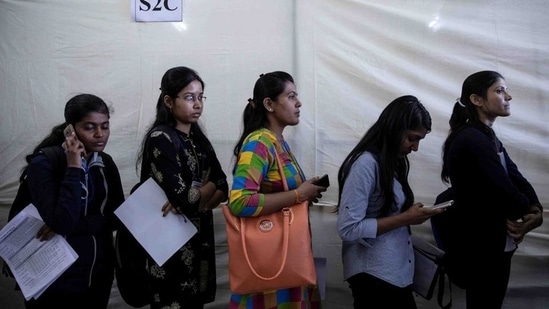Our Terms & Conditions | Our Privacy Policy
From IIT To Peon Posts In 2025, India’s Educated Are Fighting For Crumbs! How Education Has Became India’s Unemployment Trap?
Think about it – degrees without dividends – the alarming rise of educated unemployment in India, in what can only be described as a glaring paradox, over 24.76 lakh applicants have vied for just 53,749 peon positions in Rajasthan.
Among the aspirants were PhD holders, MBA graduates, law degree holders, and even civil services aspirants. The sheer volume equates to 46 applicants per post, reflecting the desperation that grips India’s educated unemployed.
However, is this an isolated incident, not at all. Remember the hundreds that have qued up in the recent months, all vying for hand full of positions.
A recent report by Unstop, a youth opportunity platform, paints a grim picture. Of the engineering and management graduates who did manage to secure internships, 25% are working without pay- no salary, no stipend, just a line on their résumé. The implication is – qualifications are no longer translating into compensation.
According to the International Labour Organization (ILO), if you hold a graduate degree in India, your chances of being unemployed are nine times higher than someone with no education at all. This completely overturns the long-held assumption that education is the ticket to a stable livelihood.
The Unstop report further reveals that 73% of recruiters now prioritize skills and talent over degrees, marking a shift from brand-name colleges to demonstrable capability. Yet, this shift in hiring practices has not alleviated the crisis, it has merely changed the rules of the game without expanding the number of seats at the table.
Despite these harsh realities, unemployment, especially among the educated, does not feature as a top policy priority for the Indian government. And that lack of urgency may be costing the nation its most precious asset – a young, ambitious, and qualified workforce with nowhere to go.
Recent data from the Periodic Labour Force Survey (PLFS), released by the Ministry of Statistics and Programme Implementation (MOSPI), reinforces this trend. Between 2021-22 and 2023-24, the unemployment rate among individuals with secondary education and above has consistently outpaced that of those with lower educational attainment.
In 2023-24, the unemployment rate for individuals aged 15 and above with at least secondary education stood at 6.5%. In contrast, the rate was just 0.2% for illiterate individuals and 1.4% for those educated only up to middle school. These numbers underline a disturbing inverse relationship: as education levels rise, so does the likelihood of unemployment.
The Unequal Burden, Educated Unemployment Hits Women Hardest
While India struggles with a rising tide of educated unemployment, women are bearing a disproportionately heavier burden. Gender disparities in employment outcomes are sharp, persistent, and deeply entrenched in both urban and rural areas.
According to the latest 2023-24 Periodic Labour Force Survey (PLFS) data, the unemployment rate among educated rural women is 9.0%, significantly higher than the 5.6% for rural men. The gap grows even wider in urban areas, where 13.3% of educated women are unemployed, compared to just 6.2% of men, a more than twofold difference.
This trend is not new. In 2022-23, the unemployment rate for urban educated females stood at 13.7%, compared to 6.8% for males. The year before, in 2021-22, it was 14.3% for women versus 8.2% for men. These consistent figures reveal that educational attainment alone is not enough to secure employment for women, who continue to face systemic barriers including socio-cultural constraints, lack of supportive infrastructure, occupational segregation, and pervasive workplace discrimination.
Women, especially in rural areas, often confront limited mobility, rigid societal norms, and a scarcity of women-friendly workplaces, which severely restrict their employment prospects, even when they are equally or better qualified than men.
The Urban-Rural Divide. Competition Without Capacity
Beyond gender, there’s another deep fissure in India’s employment scene, the urban-rural divide in job opportunities for the educated.
In 2023-24, the unemployment rate among educated individuals in urban areas is 7.9%, higher than the 6.5% in rural areas. This trend has held steady over recent years:
In 2022-23, urban unemployment was 8.4% versus 6.6% in rural regions.
In 2021-22, the numbers were 9.5% for urban and 8.0% for rural populations.
Urban areas, often perceived as hubs of opportunity, paradoxically host higher levels of unemployment among the educated. One reason is the dense concentration of degree holders in cities, which results in fierce competition for a limited number of white-collar jobs.
Another contributing factor is migration. Many educated individuals move from rural to urban areas in search of better employment prospects, but urban job markets have not expanded at a pace fast enough to absorb this influx. The result is a growing class of overqualified, underemployed youth stuck in a limbo of aspirations unmet by reality.
The Last Bit, Are We Seeing Improvement?
Analysing the data over the three-year period reveals subtle but important trends. The overall unemployment rate for individuals with secondary education and above decreased slightly from 8.0% in 2021-22 to 6.6% in 2022-23, and then to 6.5% in 2023-24.
This decline, although marginal, indicates a slow recovery or adjustment in the job market. However, the rate remains high compared to other educational levels, emphasising that the problem is far from being resolved.
Images are for reference only.Images and contents gathered automatic from google or 3rd party sources.All rights on the images and contents are with their legal original owners.



Comments are closed.